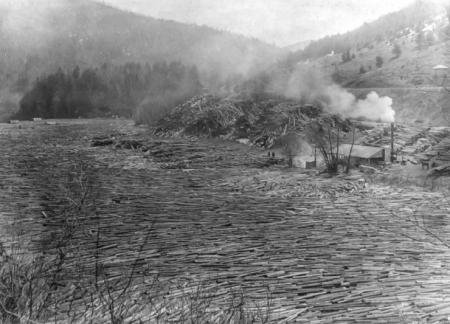Many of Vermont’s streams are currently lacking a very important habitat feature, large woody material.

Mature forests naturally contribute large woody material to streams, where it provides habitat for fish and other aquatic organisms and contributes to natural stream functions.
What Happened to the Woody Material?
In the days of the log drives, much of the naturally occurring large woody material was removed from Vermont’s streams to aid the drives. Large woody material has also been removed from streams over time due to the misguided notion that the wood is somehow dangerous or detrimental to habitat and stream functions. Furthermore, repeated timber harvest right down to the streambanks has resulted in young streamside forests, with few trees large enough to fall into streams and stay there during high flows.
Strategic Wood Addition (SWA)
The Vermont Fish & Wildlife Department and its partners are implementing a practice known as strategic wood addition (SWA) to improve fish habitat and stream functions in streams that meet a list of criteria. Chainsaw, hand tools, and muscle power are used to add and secure large woody material in streams after thorough research and careful planning.
SWA is a useful tool, but it is not appropriate for every situation, and it is not the ultimate solution to the lack of large woody material in Vermont’s streams. The long-term solution is to protect streamside forests so that their natural functions and benefits to streams can be restored and to leave large woody material in our streams.
Research & Results
Our research on SWA has proven the value of large woody material to brook trout and stream functions. In the East Branch Nulhegan River watershed, a six-year study found:
- Brook trout abundance tripled, on average, after just three years, at sites where trees were strategically felled into the stream by providing cover for trout.
- The added wood is storing sediment and organic material in these smaller headwater streams, thereby reducing sediment and nutrient loads downstream.
- The added wood also helps to slow runoff from these headwater streams, which can help to reduce flooding downstream.
Should I Consider a Strategic Wood Addition Project?
Many Vermont streams and their inhabitants will benefit from strategic wood additions. However, it is not appropriate for all streams. We've provided insights to successful project criteria below.
In this video, learn how to evaluate your potential project:
The Vermont Strategic Wood Addition Handbook can also help to determine whether strategic wood addition is appropriate for a proposed stream reach:
If you have questions about strategic wood addition, contact Fisheries Biologist Jud Kratzer at jud.kratzer@vermont.gov or 802-751-0486.
Restoration work has been conducted by the Vermont Fish & Wildlife Department and Trout Unlimited on lands owned by Weyerhaeuser, US Fish and Wildlife Service, and Vermont Fish & Wildlife. Funding has been provided by a variety of sources including: Sportfish Restoration, VT fishing license sales, New Hampshire Charitable Foundation, National Fish and Wildlife Foundation, Eastern Brook Trout Joint Venture, and Ecosystem Restoration Funds through the Vermont Clean Water Initiative Program.
